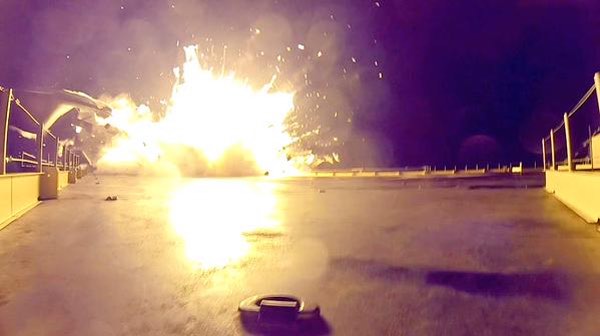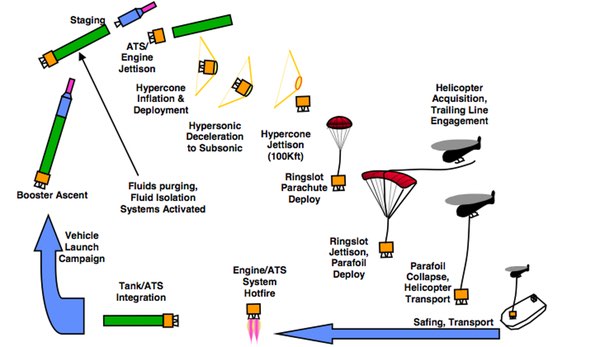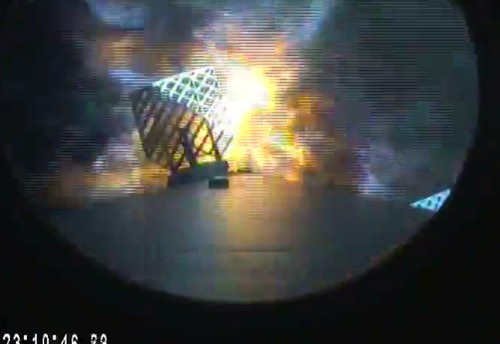Reusability revivalby Jeff Foust
|
| “I think it’s quite likely—probably 80 to 90 percent likely—that one of those flights will be able to land and refly,” Musk said in October. |
Today, the situation is changing. As SpaceX inches closer to at least recovering a rocket stage for potential reuse, including two tests in as many months that came close to landing a Falcon 9 first stage on a ship, other companies are taking notice. One company in particular, SpaceX’s strongest rival for US government missions, is now actively talking about reusing at least part of its launch vehicles.
“Close, but no cigar”
On several launches last year, SpaceX attempted to demonstrate “landing” a first stage on the ocean surface. Those tests demonstrated that the stage could reach the surface at zero velocity, but the stages themselves could not be recovered, broken apart by the seas.
In October, Elon Musk announced the next phase of SpaceX’s reusability efforts. Instead of landing the stage in the open ocean, the company would attempt to land the stage on a custom-designed ship with a deck about 90 meters long and 50 meters across. Musk said at an MIT symposium that the ship would be first used on SpaceX’s next launch, the fifth in the company’s series of cargo resupply missions to the International Space Station.
Even then, though, he made it clear that the upcoming test would not be a one-shot deal. “There’s at least a dozen launches that will occur over the next 12 months,” he said. “I think it’s quite likely—probably 80 to 90 percent likely—that one of those flights will be able to land and refly.”
That launch, delayed from mid-December due to issues with the Falcon 9 rocket as well as a period around the new year when ISS access was limited, finally took place in the pre-dawn hours of January 10. The launch itself was a success, sending a Dragon cargo spacecraft to the ISS. As for the landing attempt?
“Rocket made it to drone spaceport ship, but landed hard,” Musk tweeted shortly after the launch. “Close, but no cigar this time. Bodes well for the future tho.”
Musk said that four “X-wing” fins, located near the top of the stage and used to steer the vehicle during its descent, had worked well, but ran out of hydraulic fluid shortly before landing. The fins went “hardover,” he said later, making it difficult for the engines to compensate.
Initially Musk said there was no images of video of the landing attempt, citing both darkness and fog. But, less than a week later, he posted a set of images in response to an inquiry via Twitter from John Carmack, who also worked on vertical landing technology with Armadillo Aerospace. The images showed the stage hitting the deck of the ship at a 45-degree angle, and then exploding.
“Full RUD (rapid unscheduled disassembly) event,” Musk said in a tweet showing the last of the series of the images, of the stage exploding. “Ship is fine minor repairs. Exciting day!”
 The first stage of a SpaceX Falcon 9 exploding as it crash-landed on the company’s ship January 10. (credit: SpaceX) |
The ship, since christened Just Read the Instructions (the name of a ship in the novels of the late science fiction author Iain M. Banks), was repaired and ready to go for SpaceX’s next launch, of the Deep Space Climate Observatory (DSCOVR) spacecraft, a joint mission of NASA, NOAA, and the US Air Force. DSCOVR’s history predates that of SpaceX itself: it started as Triana, a mission NASA started in the late 1990s at the behest of then-Vice President Al Gore, to provide realtime images of the Earth from the Earth-Sun L1 Lagrange point. Triana was cancelled in 2001 but revived eight years later as DSCOVR, with a primary mission of space weather observations.
DSCOVR would be another opportunity for SpaceX to test a stage landing, although the different trajectory of the mission—flying out to L1, rather than to the inclined orbit of the ISS—presented its own challenges.
| “[T]he data captured during this test suggests a high probability of being able to land the stage on the drone ship in better weather,” SpaceX said. |
“The speed of the stage coming in is actually higher,” said Hans Koenigsmann, vice president of mission assurance for SpaceX, at a pre-launch press conference February 7, later noting that the dynamic pressure on the stage during reentry would be twice as high as the prior attempt. “That makes it a little bit less likely to succeed.”
Asked at the press conference what he thought the odds of success were, Koenigsmann said, “I think I’m going to stick with 50 percent, after careful deliberation.” Musk had said prior to the January attempt that the landing had a 50-percent chance of succeeding, only to admit in a Reddit.com chat that he made up that number. “I have no idea,” he wrote.
SpaceX was ready to launch DSCOVR, and test a stage landing, on February 8. However, a problem with an Air Force tracking radar scrubbed the launch. (There was also a problem with a telemetry transmitted on the Falcon 9 first stage, but Musk later said it was not a constraint to launch.) A second launch attempt two days later was also scrubbed, this time by strong upper level winds.
On the evening of February 11, weather was not an issue at the launch site, and both the rocket and the range were ready to launch. But weather had thrown SpaceX another curveball: high seas at the landing site, about 600 kilometers downrange from Cape Canaveral, were too rough for the ship. SpaceX officials said waves up to ten meters high, coupled with a problem with one of the four engines on the ship that keep it in position, forced them to with draw the ship. SpaceX would instead attempt what they tested in the past, “landing” the stage in the ocean, to see how precisely they could do it.
The Falcon 9 lifted off at sunset February 11, successfully delivering DSCOVR on its long-delayed journey to L1. Musk later tweeted, and the company confirmed in a statement, that the stage touched down on the ocean surface vertically, and within 10 meters of the planned position: sufficient accuracy for landing on the ship. “[T]he data captured during this test suggests a high probability of being able to land the stage on the drone ship in better weather,” the company said.
The company hasn’t disclosed when they’ll try another stage landing on its ship. At the pre-launch press conference, Koenigsmann said the next launch, of two commercial communications satellites planned for the evening of February 27, was not a candidate for a landing test (SpaceX has traditionally not tested reusability on launches of geostationary communications satellites in order to maximize the payload.) One possibility is the next mission to the ISS, currently scheduled for early April.
ULA explores reusability
Last August, United Launch Alliance announced the sudden retirement of its president and CEO, Michael Gass, who had been in charge of ULA since the merger of Boeing and Lockheed Martin’s launch vehicle divisions that created ULA was completed in 2006. ULA replaced Gass with Tory Bruno, someone not widely known in the space community but a veteran of Lockheed’s missile unit, where he was vice president and general manager before taking over ULA.
Bruno soon set himself apart as a different and, in many respects, more open leader than Gass. In December, Bruno opened up an account on Twitter, and was soon engaging with people, answering questions about ULA and its launch plans. That included questions about ULA’s launch vehicle plans, like its partnership with Blue Origin for an engine to replace the RD-180 that currently powers the Atlas V first stage, and also reusability.
“The true challenge of #reuse is economic, not technical,” he wrote in one tweet in early January. “More to say about our future at the #SpaceSymposium.” That was a reference to the Space Foundation’s annual conference in Colorado Springs in April, where Bruno said ULA would unveil its plans for a next-generation launch system.
Before the Space Symposium, though, Bruno discussed reusability more broadly in a February 4 speech at Stanford University, organized by a campus space group, the Stanford Student Space Initiative. The speech, webcast by the group, gave Bruno an opportunity to expand on his thoughts about reusability and what ULA might be contemplating.
“What if we could reuse the rocket? Would that not make launch more affordable?” he asked in his speech. That is a complex question, he argued, since “it involves a tightly coupled interaction of technology and economic considerations… It’s a much more complex, and therefore much more interesting, problem to talk about.”
| A vehicle would have to be able to refly at least 14 or 15 times to be truly “economically attractive,” Bruno said. “That’s no longer a slam dunk.” |
He spent much of his speech talking through the considerations, both technical and economic, involved with reusability. For reusability to work economically, the vehicle would have to be able to refly several times, he argued. “The good news is that you can break even, you can cover those costs of all of that stuff, probably in about seven or so reuses,” he said, citing studies performed by his company, NASA, and others. “That’s not bad.”
However, he said that a reusable vehicle had to do more than break even in order to justify the investment in reusability. “As it turns out, that cost recovery curve with reuses gets kind of flat and shallow,” he said. A vehicle would have to be able to refly at least 14 or 15 times to be truly “economically attractive,” he said. “That’s no longer a slam dunk.”
Bruno talked through the technical issues associated with reusability, covering some familiar ground for those who have been following SpaceX’s efforts. Recovering the first stage was “more forgiving” that the upper stage, he said. Simply having the first stage land on parachutes in the ocean, though, was also undesirable: “There is not one single thing on a rocket that likes salt water,” he quipped.
That pushed him towards returning the stage on land, which is SpaceX’s long-term goal as well (the company announced an agreement with the Air Force last week to lease Launch Complex 13 at Cape Canaveral to serve as a landing site for Falcon first stages.) A parachute landing on land was not advisable, he said, given the hard jolt to the stage that any parachute landing would generate. “That means you have to bring it back under controlled flight,” he said.
That sounds like SpaceX’s plans, but then Bruno diverged. “What if everything on that booster wasn’t of the same value? What if something on there was a lot more valuable than something else, and we could just bring that part back?” he asked.
As it turns out, of course, not everything on a launch vehicle has the same cost. “Most of the cost of a first stage booster is just one element: its rocket engine. It’s like two-thirds of the cost,” he said. “Maybe if we could come up with a systems engineering, technical solution to get just that part back, and it wasn’t too complicated and it wasn’t too expensive to recover it… we might be able to find a way to make this economically work.”
Bruno declined to go into greater details about this option, suggesting that he’ll go into more detail about ULA’s launch vehicle and reusability plans at the Space Symposium. But if ULA is indeed looking at ways to recover just the first stage engines of its next-generation booster, it won’t be the first time the company has studied this approach.
In a paper presented at the American Institute of Aeronautics and Astronautics’s (AIAA’s) Space 2008 conference, a team of ULA engineers discussed a similar approach for the company’s Atlas V rocket. In that concept, the RD-180 engine module and Aft Transition Structure (ATS) would separate from the first stage after stage separation. That work would require only modest modifications to the structure, they said.
 An illustration from a 2008 AIAA paper shows ULA’s concept for recovering and reusing the Atlas V first stage engine module. (credit: ULA) |
That engine/ATS module would then deploy a “hypercone”, a type of inflatable ballute to slow the stage down and protect it during reentry. The module would later release a parachute, and then a parafoil, to further slow it and to steer it. A helicopter would perform a midair recovery of the module, setting it down on land or a ship for transport back to the launch site.
“The ATS remains dry, and the setdown method is virtually zero impact, minimizing engine refurbishment scope and cost,” the authors note in the paper, echoing some of the considerations Bruno brought up in his speech. “This approach balances existing technology, realistic flight rates, and operational robustness to enable cost effective recovery and reuse of the RD-180.” The paper also projected maximum cost savings to result for three flights of the engines “without pushing the engine into extreme run times.”
| “There will come a day when we’re going to and from space every day. There will be thousands of men and women living and working off this planet,” Bruno said. “When we are that point, expendable launch vehicles are not going to be practical.” |
ULA followed up that paper with a 2010 paper, this one with a focus on plans to test the hypersonic decelerator technology. That technology, they argued, could be tested on Atlas V launches itself, making use of an external payload carrier with the same size and shape of a solid rocket booster used on the Atlas V first stage.
Whether that approach, or something like it, is in fact what ULA intends to pursue will have to wait until mid-April at least, when Bruno discusses the company’s vehicle plans at Space Symposium. In his Stanford speech, though, he indicated that reusable vehicles of some kind will be needed to realize his long-term vision of spaceflight, one not that different from the decades-old dreams of many space enthusiasts.
“There will come a day when we’re going to and from space every day. There will be thousands of men and women living and working off this planet,” he said. “When we are that point, expendable launch vehicles are not going to be practical… We will be driven directly to a single stage to orbital reusable spacecraft. That’s the way it’s going to be.”
